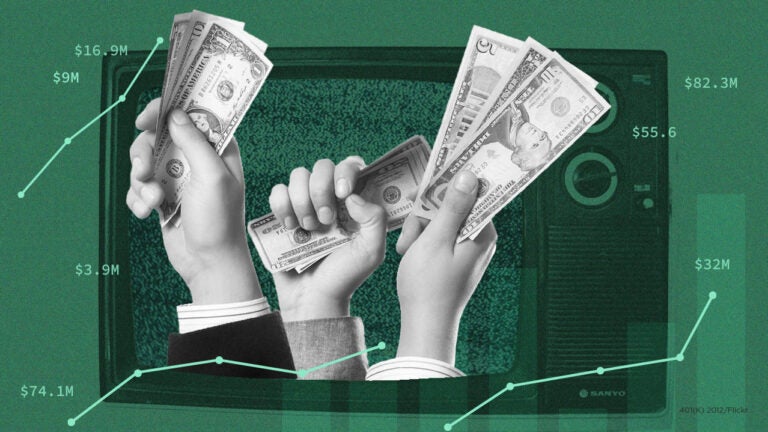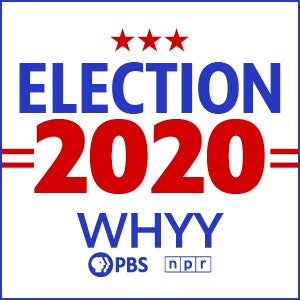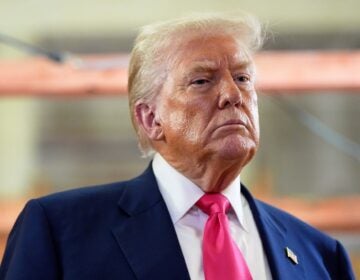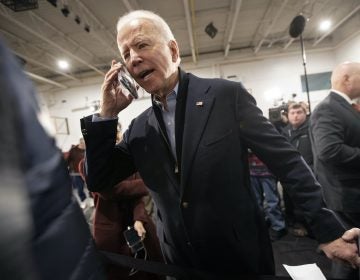Biden has the advantage on the airwaves with weeks to go in campaign

The latest ad analytics show that President Trump is spending in Ohio and Iowa, two places where Trump should be favored.
Updated 6:57 p.m. Friday ET
Despite reports of the Trump campaign canceling TV advertising in Ohio and Iowa, it turns out the campaign has $11 million still reserved for ads in the states, according to the latest ad spending data provided to NPR by the ad-tracking firm Advertising Analytics.
The Trump campaign ran no ads in either state for the week of Oct. 4, but it still has $8 million in Ohio and almost $3 million in Iowa reserved for the final four weeks of the campaign.
Both Ohio and Iowa should be states where Trump is favored. He won them both in 2016, and high percentages of their populations are white voters without a college degree, a strong pro-Trump group.
But polls have shown the races in both places to be within the margin of error, and the ad spending bears that out. With limited resources to spread around among key states, TV ad spending is as good an indicator as almost anything else for where the campaigns and outside groups supporting them see the contest as most competitive.
“President Trump and his campaign are extremely confident that we’ll win Iowa and Ohio,” Samantha Zager, deputy national press secretary for the Trump campaign, said in a statement. “We have been talking directly with voters for years in these states about the success of President Trump’s America First agenda, whether through our top-tier ground game, in-person and online events, or utilizing digital, TV, and radio ads. Unlike Joe Biden, campaign ads aren’t the only way we know how to campaign.”
It’s no surprise then that Florida and Pennsylvania are the two states seeing the most spending, head and shoulders above the rest when it comes to ads run or booked between the end of September through Election Day.
Florida, with its many TV markets and history of close races, is perennially one of the most expensive states to campaign in. That’s no different in 2020, as $112.5 million is being spent there in the final six weeks of the campaign between the campaigns and outside groups.
In Pennsylvania, it’s $68.3 million. Michigan at $43.7 million, North Carolina at $36.9 million, Arizona at $31.7 million and Wisconsin at $29.8 million round out the big six states, where the campaigns are betting the election will largely be decided.
After that, there’s a significant drop off — Minnesota and Nevada are at about $16 million, followed by Ohio at $13.1 million, Georgia at $10.4 million, Iowa at $8 million, Texas at $6.7 million and New Hampshire at $5.1 million.
Outside spending
Campaigns only fund part of what gets seen on TV that benefits one side or the other.
There are almost three dozen groups that are spending about $209 million in 10 states in this final six-week stretch of the campaign. To put that in perspective, it’s more than half of all the TV spending. (The campaigns are spending about $189 million total.)
By far, Biden is benefitting most from outside groups, almost 3 to 1. Pro-Biden outside groups are spending $152 million on ads, compared to $56 million by pro-Trump outside groups.
The pro-Biden groups are walloping pro-Trump ones in seven of the 10 states, including seven of the top eight — Florida, Pennsylvania, Michigan, Arizona, Wisconsin, Minnesota and Nevada.
Pro-Trump outside groups are outspending pro-Biden groups in North Carolina, Georgia and Iowa.
So which groups are spending the most?
By far, the outside group spending the most in these last six weeks of the campaign is the Democratic super PAC Future Forward USA, buying up a whopping $79 million in ads. That includes $24 million in Pennsylvania, $18 million in Michigan, $9 million in Nevada and Wisconsin, and $8 million in Florida.
It’s a fairly new group that is run by two former Obama campaign officials.
After that, the top spending pro-Biden group is Priorities USA at $21 million.
On the Republican side, America First tops all groups, spending $36 million, followed by Preserve America PAC at about $15 million.
A deeper look at the ad spending in each state
Here’s a state-by-state breakdown in order of where the campaigns are spending the most. The list is in order of the amount spent overall, and the totals include the outside groups supporting each candidate and/or opposing his opponent. Data include TV ad spending from Sept. 27 through the week of Nov. 1.
Florida: $112.5 million
Biden and allies: $70 million ($18.5 million from campaign)
Trump and allies: $42.5 million ($25 million from campaign)
Pennsylvania: $68.3 million
Biden and allies: $45.7 million (13.6 million from campaign)
Trump and allies: $22.6 million ($9.6 million from campaign)
Michigan: $43.7 million
Biden and allies: $36.5 million ($10.7 million from campaign)
Trump and allies: $7.2 million ($7 million from campaign)
North Carolina: $36.9 million
Trump and allies: $20.8 million ($11 million from campaign)
Biden and allies: $16.1 million ($13.7 million from campaign)
Arizona: $31.7 million
Biden and allies: $22.2 million ($12.2 million from campaign)
Trump and allies: $9.5 million ($6.3 million from campaign)
Wisconsin: $29.8 million
Biden and allies: $20.4 million ($7.6 million from campaign)
Trump and allies: $9.4 million ($3.4 million from campaign)
Minnesota: $16.2 million
Biden and allies: $9.5 million ($3.5 million from campaign)
Trump and allies: $6.7 million (all from campaign)
Nevada: $15.7 million
Biden and allies: $12.2 million ($2.7 million from campaign)
Trump and allies: $3.5 million (all from campaign)
Ohio: $13.1 million
Trump and allies: $7.9 million (all from campaign)
Biden and allies: $5.2 million (all from campaign)
Georgia: $10.4 million
Trump and allies: $5.9 million ($1.5 million from campaign)
Biden and allies: $4.5 million ($4.3 million from campaign)
Iowa: $8 million
Trump and allies: $5.5 million ($2.7 million from campaign)
Biden and allies: $2.5 million (all from campaign)
Texas: $6.7 million
Biden and allies: $6.7 million ($6.6 million from campaign)
Trump and allies: $29,000 ($27,000 from campaign)
New Hampshire: $5.1 million
Trump and allies: $2.8 million (all from campaign)
Biden and allies: $2.3 million ($2.2 million from campaign)
9(MDAzMzI1ODY3MDEyMzkzOTE3NjIxNDg3MQ001))





